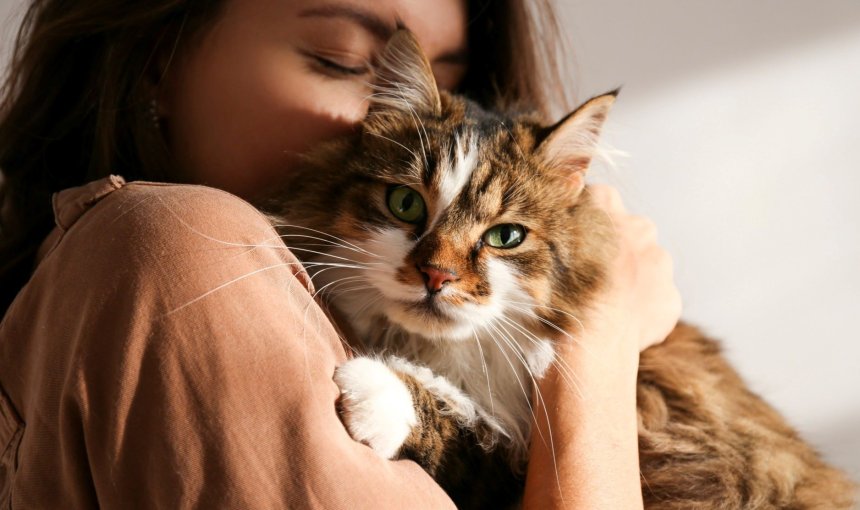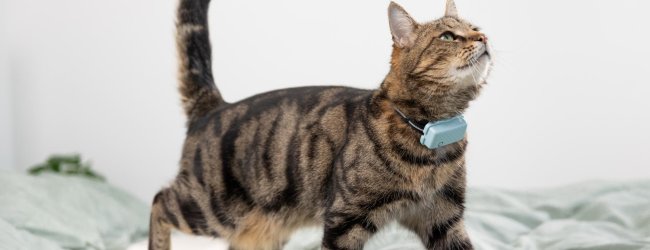10 Hypoallergenic Cat Breeds For Sneeze-Free Snuggles
Want a cat but you’re allergic? Hypoallergenic cat breeds may be the solution for you.

You know the feeling: itchy, watery eyes, the urge to sneeze, and a runny nose. This can only mean that a cat is nearby! Unfortunately, some people are allergic to cats, making it impossible to be in the same space with a cat, or even in a room where a cat has been. But there is hope for cat-lovers with cat allergies. Check out these 10 best hypoallergenic cat breed – which one will be your new feline friend?

Find out where your cat spends their time.
Read moreWhat causes people to be allergic to cats?
You might think that cat fur triggers your allergic reaction. But it’s actually cat saliva, sebaceous (oil) glands, and dander (dead skin) that are the problem. These substances contain a protein called Fel d1. If you are sensitive to this Fel d1 protein, you may have an allergic reaction if the protein touches your eyes, nose, or mouth.
When cats groom themselves by licking their fur, the Fel d1 protein molecules that naturally occur in their saliva are transferred to the fur and skin. Once the saliva dries, the tiny protein molecules are launched into the air when the cat moves about. And if you pet the kitty, the Fel d1 proteins get on your hands. If you then touch your eyes, nose, or mouth, your body reacts to the Fel d1 allergens with the classic symptoms that allergy sufferers dread.
The tiny protein molecules can stay suspended in the air for hours, then land on furniture, carpets, and clothing. For people who are extra-sensitive to these proteins, symptoms can be triggered by just walking into a room where a cat has been.
Factors that affect allergen production in cats
The Fel d1 protein is produced by all cats. But some breeds produce less of this allergy-triggering protein than others. Several factors can affect the amount of Fel d1 proteins that a cat produces:
- Male cats secrete more allergen proteins than female cats.
- Intact males produce 3 to 5 times more allergen proteins than neutered males.
- Black cats or cats with dark-colored fur produce more allergen proteins than cats with light-colored fur.
- Kittens produce fewer allergen proteins than adult cats.
Are there 100% hypoallergenic cats?
There is no such thing as a “100% hypoallergenic” cat. That’s because all cats produce the Fel d1 protein that causes allergy symptoms in people. But some cat breeds produce far less of these allergens than others. While no cat is truly 100% hypoallergenic, the breeds below can make it easier for allergy sufferers to invite a kitty into their home.
Even though specific breeds are recommended for allergy sufferers, you still have to do your homework and gather facts before finding the perfect pet. Each individual cat has a different level of allergen production, and each individual person has varying levels of sensitivity to cat allergens. The best way to determine if you are sensitive to the cat you wish to adopt is to meet the cat in person before taking them home.
Best hypoallergenic cat breeds for people with allergies
Many of the hypoallergenic cats on this list have two things in common: they naturally produce fewer Fel d1 proteins, or they have only one layer of fur rather than the three layers found in most cats. With less fur, they shed fewer hairs and fewer cat allergens drift into and around your living space.
Shorthair cats, Rex cats, and relatives of Siamese cats are commonly recommended for pet parents who suffer from cat allergies yet desperately want a cat.
Check out these hypoallergenic cat breeds and decide which breed might be best for you to safely snuggle up with stay sneeze-free.
1. Devon Rex
These curious cats have only a single layer of fine, slightly curly hair and shed less than other cats. This means that less fur and dander will be present in your home and your allergy symptoms may be triggered less often. It’s not uncommon for adorable Devon Rex cats to purr loudly when they are content during daily cuddle time.
2. Sphynx
Sphynx cats are nearly hairless, so they rank high on the list of hypoallergenic cats. Because they don’t have much hair, Sphynx cats groom themselves less often than long-haired cats. As a result, they transfer less protein-containing saliva to their body and trigger fewer symptoms for allergy sufferers.
Hairless cats like the Sphynx actually have a fine coat of downy fur, similar to peach fuzz. They require some extra care, including frequent bathing and occasionally applying oil to their skin to keep it in good condition. These unique cats are lively, have lots of energy, and love attention from their humans. Some people compare the Sphynx cat’s personality to that of a dog!
Always Know Where Your Cat is With Tractive GPS
3. Russian Blue
Producing less Fel d1 proteins than other breeds despite their thick double coat, Russian Blue cats can be a good choice for people with cat allergies. This breed is known for their playfulness and loyalty. Don’t be surprised if your Russian Blue cat follows you around the house all day and is just a bit nosey.
4. Cornish Rex
Like their relatives the Devon Rex cats, Cornish Rex cats have just one layer of fine hair and tend to shed less. These cats have a unique appearance, with long legs and large ears. Because of their unusual coat, they may require occasional bathing to remove oil buildup on the skin. Your Cornish Rex will be a loyal companion, and might become a bit demanding when they don’t get enough of your attention. These intelligent cats can even be trained to walk on a leash. But first, learn how to harness train your cat.
5. Oriental Shorthair
This cat breed comes in two varieties – shorthair and longhair. Oriental Shorthairs are better for allergy sufferers due in part to their short, silky coats and less shedding. Regular brushing keeps their fur in good condition.
With their large ears, almond-shaped eyes, and talkative tendencies, Oriental Shorthairs make engaging companions for cat lovers. They are known to get along well with other pets in your home. You can find more than 300 colors and patterns in the Oriental Shorthair breed, including white, chestnut, ebony, and blue, as well as solid, tabby, and bi-color patterns.
6. Colorpoint Shorthair
A close cousin of the Siamese cat, the Colorpoint Shorthair is gaining popularity but is not an officially-recognized breed. Like Siamese cats, Colorpoint Shorthairs are chatty and sensitive to the moods of their pet parents. If you’re looking for a quiet kitty, a Colorpoint Shorthair may not be the cat for you.
7. Siberian Cat
Yes, they’re furry, but that doesn’t mean that Siberian cats aren’t hypoallergenic. These beautiful cats have a triple coat but produce much less of the Fel d1 protein than other cat breeds, making them a good option for people with mild allergies.
Weekly brushing is important to help your Siberian cat maintain a healthy coat. During shedding season, daily brushing is a must (preferably done by a friend or family member who is not allergic to cats). Siberian cats have laid back personalities, which makes them good choices for homes with young children.
8. Javanese Cat
Javanese cats are a top choice for minimizing allergens in homes with cat allergy sufferers. Instead of the three layers of fur found in a typical cat’s coat, the Javanese cat has only one layer, making it one of the lowest-shedding breeds. The breed originated by crossing a Balinese cat with a Colorpoint Shorthair. Despite their name, these cats did not come from the Indonesian island of Java.
Similar to many Siamese-like breeds, Javanese cats are vocal and enjoy having conversations with their pet parents, or just talking to themselves. Javanese cats don’t hesitate to express their displeasure when things are not to their liking. These kitties are agile and muscular, despite their fragile, slender appearance. Javanese cats like nothing better than cuddling up with you after a busy day of following you around the house.
9. Bengal Cat
Large and muscular, Bengal cats were bred in the United States by crossing wild Asian Leopard cats with Domestic Shorthair cats. Bengal cats don’t groom or shed as much as other cats. As a result, they are ideal options for people who are allergic to cats.
True to their wild roots, Bengal cats are energetic and need to stay active to avoid boredom or destructive behavior. If you choose a Bengal cat, be prepared to spend plenty of time playing with your furry friend. A catio or outdoor space is an ideal place for these active kitties to hang out.
10. Ocicat
Bred by crossing Abyssinian and Siamese cats in the 1960s, Ocicats look similar to Ocelots, which are medium-sized wild African cats. Despite their exotic appearance, Ocicats are definitely domestic cats. With fine, short coats, Ocicats might be a good option for pet parents who are sensitive to cat allergens.
Ocicats are athletic with lots of energy. Plan on frequent play or training sessions with these very social and intelligent cats.
Other hypoallergenic cat breeds to consider include Burmese cats, which are relatives of Siamese cats, and Balinese cats, which are sometimes referred to as “long-haired Siamese.”
How to reduce cat allergens in your home
Even a hypoallergenic cat will produce some level of allergens in the form of Fel d1 proteins. To successfully co-exist with a cat, you may have to take extra-special care of your kitty or make simple changes to your routine to reduce the amount of cat allergens in your home.
Keep your cat clean and healthy
Some veterinarians recommend giving your cat fish oil or omega-3 fatty acids to keep their coat healthy and reduce the amounts of allergens on the cat’s body. Check with your veterinarian before giving your kitty supplements.
Giving your cat a bath helps reduce the levels of offending proteins, but bathing a cat is challenging, to say the least. Instead of bathing, try brushing their coat regularly and run a fine-toothed comb through their fur to remove dander. Of course, brushing and combing are likely to stir up the proteins on your cat’s body, so you may need to enlist the help of a non-allergic friend or family member for this job.

Track your cat wherever they go
See where they are in real-time, no matter how far they roam. Discover their territory. Get alerted if they go too far. Track activity, sleep, and receive health alerts if your cat’s activity changes. Keep your feline friend healthy and safe.
Don’t sleep with your cat
We know you want to snuggle with your cat as much as possible, but keep your cat out of your bedroom so you don’t have to inhale the allergens all night long.
Some cat parents set up nighttime sleeping areas for their cats in heated garages or partially enclosed patios, depending on the weather where you live. Isolating your cat for eight hours a night while you sleep comfortably may give you the relief you need to enjoy your kitty’s company all day long. Your cat will be extra happy to see you in the morning.
Clean bedding and cloth surfaces often
The allergens shed by your cat will land on every surface in your home, so frequent cleaning is important to keep the allergens from accumulating. Use washable pillow and mattress covers, and toss them in the washer weekly. Put washable covers on your sofa and upholstered furniture and clean them frequently.
If you have carpet throughout your house, consider removing or reducing the number of carpets in your home. It’s easier to vacuum up fur or dander from a wood or tile floor than to get it out of a plush carpet.
Add ventilation
HEPA filters can help remove tiny allergens from the air in your home. If the weather allows it, open some windows or allow your cat to hang out on a secure screened-in porch or cat-safe balcony to keep allergens out of the home.
Enjoy life with your hypoallergenic cat
Though it may require extra work and careful planning, it is possible for allergy sufferers to coexist with a cat. Gather hypoallergenic cat facts from friends, other cat parents, and veterinarians so you can find the right hypoallergenic breed, personality, and characteristics to match your needs. It will all be worth it the first time your furry friend curls up on your lap and starts purring!



